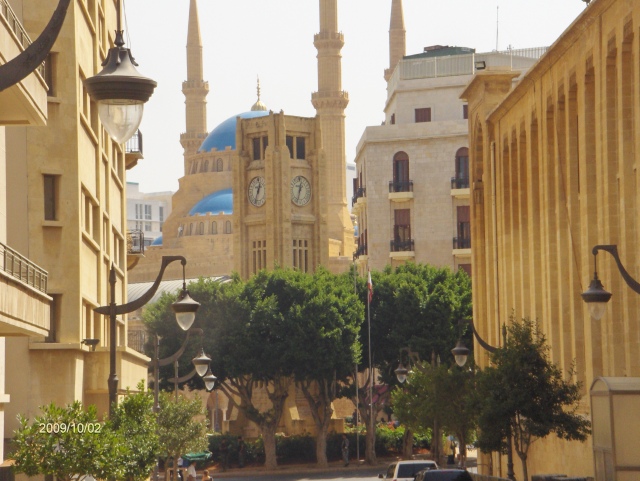
I left the yellow leaves and looming cold of Swedish fall, for the sunbathed, seashored, mountainous land of Lebanon. For the heart of the Middle East.
I LIVED IN MREISSEH, West Beirut, the beautiful Corniche nearby. I worked in the pulsating ‘hood of Gemmayzeh in East Beirut. Every day I walked between the geographical extremities of the city, the deep blue Mediterranean constantly in my sight, glowing seductively in what seemed like an eternal sunshine.

Deserted Green line, during war 1975-90.
THROUGH DOWNTOWN Beirut and the beauty of its yellowish retro buildings, past the great Mohammad Al-Amin Mosque, into Gemmayze and its colonial buildings and cozy bars.
DURING THE WAR in 1975-1990, West Beirut was controlled by Muslim militias and East Beirut by Christian militias. The city was divided by the “green line”, a broad no man’s land cutting through the entire city. It was turned into ruins.

Downtown Beirut, rebuilt in the 1990s after the war.
FOLLOWING the war, huge restoration commenced, and all downtown was transformed into an urban heaven of old-fashioned, romantic charm, everything draped in sand-colored stone that could have been centuries old if you didn’t know. I cherished walking though every day, armed soldiers guarding street corners the only reminder of a fragile society.
My bleeding heart is slightly relieved – post blast, it is still standing.
ADORABLY CHAOTIC Beirut was alive like few cities of the world. During days, I wrote of politics and African civil wars for the Daily Star Newspaper. During evenings, I relished the lack of street crime and this lively allure.

Sweet Corniche. Photo: Filip Ericsson
I WALKED up the hill into the sparkling district of Hamra, passing the notable American University where herds of students were hanging around, wrapped in their happy bubble of student life. By rows of frantic fast-food places they clustered during eternal, lukewarm Summer nights.
Then came the blast.
“GEMMAYZEH – Beirut’s beating heart” wrote my old colleague at the Daily Star, Richard Hall, in The Independent a few days ago.
“TO LOOK at what was destroyed in Gemmayze is to go some way to understanding what Beirut has lost: Not only lives, family members, friends, but part of the soul of the city…all gone in an instant.”

Cozy, free-spirited Gemmayze Before blast.
“GEMMAYZEH is freedom. Whatever you wanna wear, whatever you wanna say, whoever you wanna kiss, whatever you wanna do. It’s a beautiful place.”
Gemmayze is gone, and hearts are crying.
BUT LEBANON, can you rise again? Eternal refugee camps with stateless Palestinians, Iran that exercises military power and controls politics through Hezbollah, the international sanctions and tense relations with Israel because of it, and spillovers from the Syrian war with its many refugees, are all factors that hamper any development.

City beach, West Beirut. Photo: Filip Ericsson
BUT FIRST and foremost, it is the dysfunctional power-sharing political system along ethnic-religious lines that effectively keeps all political and economic development in chains.
TO REBUILD Lebanon, they must break that system and build a new one. Lebanon’s democratic history, ethnic diversity, educated diaspora, excellent geographic position and lucrative tourism, could make it happen. But only in parallel with a new, healthy political structure. And that includes the ceasing of Iran’s meddling and, consequently, the disarmament of Hezbollah.

Beirut before blast.
Filip Ericsson
